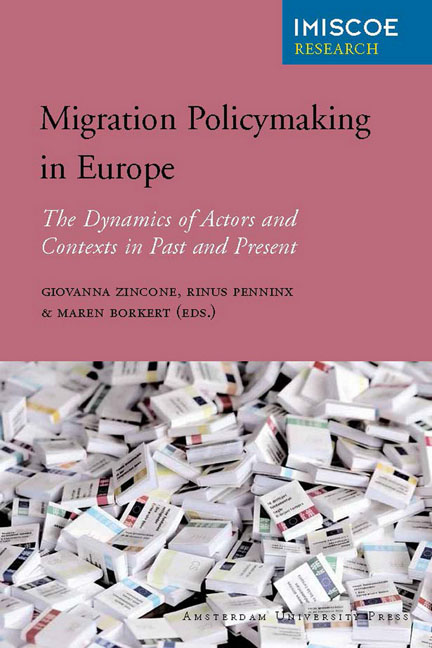Book contents
- Frontmatter
- Contents
- Policymaking in the Field of Migration and Integration in Europe: An Introduction
- Part I Post-War Migration Countries
- Part II Mediterranean Migration Countries
- Part III Eastern European Countries
- Conclusion: Comparing the Making of Migration Policies
- List of Contributors
- Other IMISCOE Titles
8 - The Case of Spain
Published online by Cambridge University Press: 20 January 2021
- Frontmatter
- Contents
- Policymaking in the Field of Migration and Integration in Europe: An Introduction
- Part I Post-War Migration Countries
- Part II Mediterranean Migration Countries
- Part III Eastern European Countries
- Conclusion: Comparing the Making of Migration Policies
- List of Contributors
- Other IMISCOE Titles
Summary
Introduction
Foreign migration to Spain is relatively recent and so, consequently, are policies related to both immigration and the integration of immigrants. The first law dealing with these issues was the Ley de Extranjería, a law on the rights and freedoms of foreigners in Spain (from herein simply referred to as the Foreigners Law) that was enacted in 1985, just a year before Spain joined the European Communities. At that time, there were merely 250,000 legal foreign residents in the country (Watts 1998: 661). During the last two decades, however, immigration flows have swelled significantly to produce a completely new demographic situation. Today the nation hosts more than 4.5 million foreign residents, which represents about 10 per cent of the total population. This makes Spain one of the European Union's leading immigration countries. Spain's percentage of immigrants in relation to its total population has reached a level comparable to that of other North-Western European countries. Growth has been especially visible in certain regions such as Madrid, Catalonia, Andalusia, Murcia, Valencia, the Balearic Islands and the Canary Islands. This particular background makes the Spanish case an interesting one to contrast with other North-Western and Central European countries. A long-standing tradition of emigration that lasted up until just recently and the increasing momentum that immigration has gathered in two decades have geared Spanish policymaking to a starting point distinct from those that came before it.
Studying Spanish policymaking in these fields is not easy. Although there is a fast-growing body of scientific literature on Spanish immigration and the social processes of newcomers’ integration into Spanish society, little research has been systematically undertaken to examine the processes of how policies in these fields are made (Agrela Romero & Gil Araujo 2005; Carrillo & Delgado 1998; Casey 1998c; Lopez Sala 2005b; Morén Alegret 2005b; Ramos, Bazaga, Delgado & Del Pino 1998; Ramos & Bazaga 2002; Ruiz Vieytez 2003; Tamayo & Delgado 1998; Tamayo & Carrillo 2002; Zapata-Barrero 2002, 2003a; Kreienbrink 2008). Most literature on policy deals with the content of policies. Even works that specifically focus on the making of policies do not offer a comprehensive view: focus falls either solely on immigration or integration; merely one aspect of either field is analysed; or only a static description is given of relations between actors at a given moment in time.
- Type
- Chapter
- Information
- Migration Policymaking in EuropeThe Dynamics of Actors and Contexts in Past and Present, pp. 291 - 324Publisher: Amsterdam University PressPrint publication year: 2012
- 3
- Cited by



